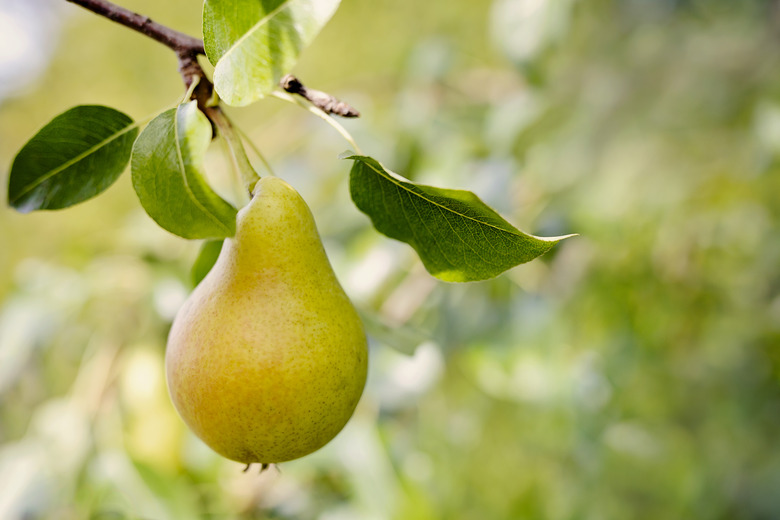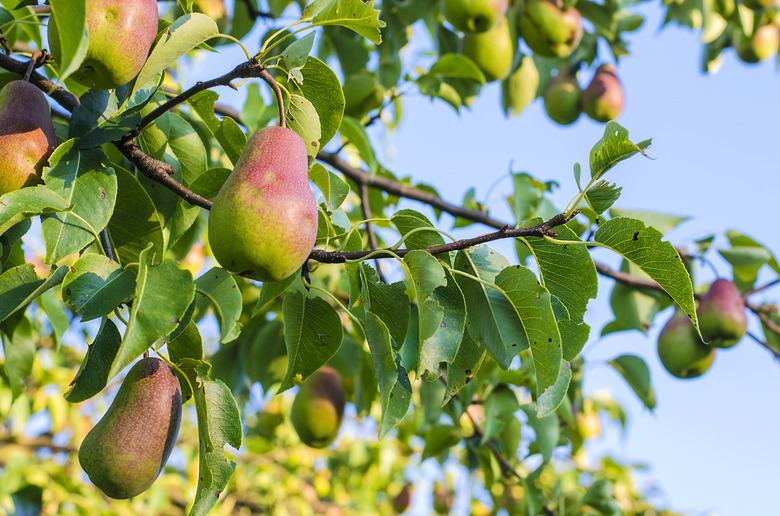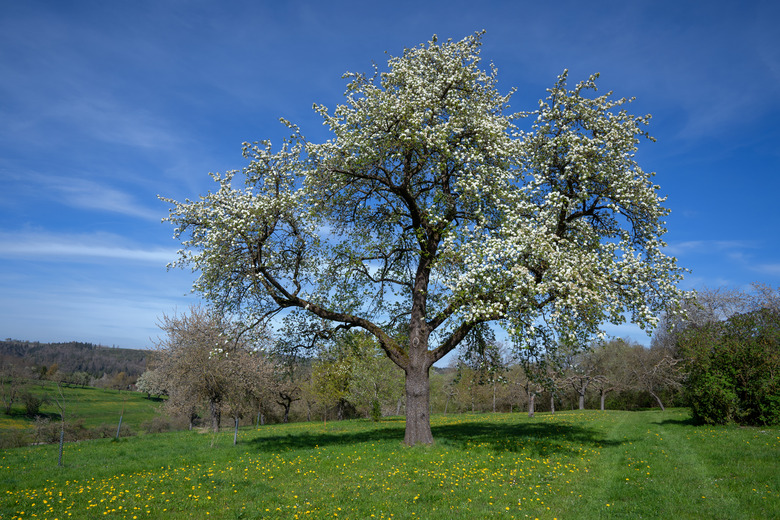How To Grow Pears
The edible pear tree (Pyrus communis, USDA zones 4-8) is a prolific producer of fruit. Also known as the common pear or European pear, the pear tree has been around for more than a thousand years, originating in Asia. Its longevity might be due to the fact that it's a fairly hardy tree. It can handle a wide variety of climates and is resistant to fluctuating weather conditions, unlike the more delicate apple tree. Overall, there are more than 3,000 cultivars of pears.
Nowadays, most pears are produced in Asia, though the trees are commonly grown in home gardens across North America. They're easy to grow and maintain, and they often grow very tall — up to 40 feet. The blossoms start as bright-green buds that transform into brilliant white flower clusters. Each cluster gives off a faint, sweet scent. Pear tree foliage has an oval shape with toothed edges. Leaves go from bright green to golden and then black as the seasons change.
How to Grow Pears
Here's here to properly grow a pear tree:
- Plant your trees at least 20 feet apart. You can get away with closer spacing — 12 feet apart — if you're planting dwarf or semidwarf trees.
- Dig a hole deep and wide enough so that it can accommodate the entirety of the sapling's root ball.
- Skip adding amendments or fertilizer to the planting hole.
You can plant pear trees in containers but make sure to pick a cultivar suitable for container growing. A large cultivar that will grow up to 40 feet won't do well in a pot.
When choosing a sapling to bring home from the nursery, pick one that doesn't show any signs of disease. You should also check under the leaves for pests. Starting off with a healthy plant increases your chances of success.
You'll typically need two saplings to ensure blossoms get pollinated. They should also be different pear cultivars. The majority of pear cultivars don't self-pollinate. That said, if someone nearby has a pear tree, you might be able to get away with planting a single tree. If you absolutely don't want to plant two trees, you can purchase grafted rootstock or a multipear cultivar to ensure cross-pollination.
Ask the seller about the age of the sapling, and avoid choosing large trees. They may be older, but the stress of being dug up can diminish overall quality. You should know that it can take pear trees a while to set and bear fruit — three to 10 years depending on the cultivar. Some cultivars will produce fruit early but won't put out a full crop of fruit until they're at least 5 to 7 years old.
Where to Plant Pear Trees in the Yard
When considering a planting spot for your pear tree, make sure you know how tall your tree will grow. Is it a large or small cultivar? Avoid planting it somewhere with overhead obstacles, like power lines. A full-grown pear tree may also obstruct the view of your surroundings. Pear trees don't take long to become established, and transplanting a mature tree to another location isn't really an option, so take your time when choosing a planting location.
Pear trees are a great choice for large and small yards alike. Their statuesque appearance makes a definite statement and provides plenty of shade at the height of a blistering hot summer. Some people grow a single pear tree for its ornamental value.
In What Zone Do Pears Grow Best?
Pear trees are best suited for USDA plant hardiness zones 3 through 8, although some cultivars prosper in zones 9 and 10. In humid climates, planting pears trees where they'll get plenty of morning sun can help prevent disease. The early sun exposure helps dry off leaves that become wet from condensation.
While some cultivars are adapted to warmer climates, most pear cultivars need at least a brief chill period in order to produce a crop of fruit.
When Should You Plant Pears?
Bare-root pear trees should be planted in the early spring when the soil becomes workable. You can also plant dormant trees in the winter (provided that the soil is workable). If trees are planted in pots (e.g., not dormant), you need to wait until the frost risk is over.
Soil, Sunlight, and Water Recommendations for Pear Trees
|
Soil |
Sunlight |
Water |
|
Fertile, well-draining soil |
Full sun |
Deep weekly watering for young plants; an inch weekly for established |
Pear trees do best in full sun. You can get away with planting your tree in partial sun but expect it to produce fewer pears. Avoid planting in partial sun if you live in an area with high humidity. Regardless of where you live, plant pear trees in an area with fertile, well-draining soil.
If you live in a humid climate, select blight-resistant cultivars. Pear trees need good air circulation to resist high moisture levels and disease, but it can be hard to control humidity levels in humidity-prone regions.
When dealing with young trees, watering deeply during dry weather ensures the roots have a chance to become established. Weekly watering is usually needed for young plants. A 2- to 3-inch layer of mulch can help conserve water for thirsty saplings. Just be sure not to put too thick of a layer, which can suffocate the root system. The soil around the base the trees should be moist but not soggy. Once established, an inch of water a week is enough — rainfall included. Watering is particularly important when young pear trees are flowering or fruiting.
Mature trees are relatively drought-tolerant and can get away with less water. However, they may benefit from deep waterings during summers with prolonged dry spells.
How to Winterize Pears
While established pear trees don't really need winter protection, small saplings benefit from some coddling. Tree-trunk wraps can help prevent damage related to midwinter thaw and freeze cycles. Don't prune trees in the fall or winter. This can leave them susceptible to frost damage.
How to Harvest Pears
When it comes time to harvest pears, you'd better have a plan! Established pear trees produce rapidly and within a small window. You should harvest the fruit when it's still firm. You'll know pears are ready to pick if they're green with a yellow tinge and are still firm. Some cultivars will have dots that turn brown, signaling the fruit is ready to pick. They'll ripen when set out at room temperature. Fruit that ripens on the tree is actually less palatable, so make sure you keep an eye on your pears and harvest them before they ripen.
In the fridge, mature (but not yet soft) pears will keep for about a week. In a dark, cool and dry place, most cultivars will keep for up to two months if stored in containers. Some cultivars keep longer than others. Anjou pears, for instance, can be stored for up to six months and actually require a period of cold storage. Bartlett pears, another popular cultivar, also need some time in cold storage for optimal flavor.
You pick pears pretty much the same way you harvest apples: Grab, lift, and twist the fruit while making sure to be gentle enough that the branch isn't damaged in the process.
Common Pests and Other Problems for Pear Trees
Some common pear tree pests include aphids and mites. Both are relatively easy to control, especially if your tree is already healthy. Here are some other common pests for pear trees:
- Japanese beetles: These pests are probably the most irritating of all pear tree pests because they can do significant damage in a fairly short span of time. Control them by removing them manually and tossing them into soapy water. Thankfully, these beetles sometimes arrive in gardens on a cyclical basis. You may have an issue with them in one year and not the next.
- Small animals: Animals like voles and squirrels can also be an issue for pear trees. However, pear trees produce so prolifically that it's unlikely your entire crop will be devastated by hungry garden critters. Tree guards can help prevent trunk damage from voles.
Poor air circulation and low fruit set might be the result of a lack of pruning. Although pear trees are reasonably low-maintenance, some annual pruning is required to encourage production and prevent disease. Central leader system pruning is recommended for most types of pear trees; this type of pruning results in a shape like a Christmas tree. The idea is to remove branches directly above one another. Pruning should take place in the spring once the risk of frost has passed. You should start pruning in the first year.
Tip
Don't forget to thin out your pears. Trees that continually produce a full crop without intervention on your part may be susceptible to limb damage and breakage. Letting your tree produce a full crop one year can significantly diminish production in the next. Early thinning ensures pears grow to their full size and next year's crop remains sizable. To thin out pears, remove all but one fruit per cluster and make sure each cluster is about 6 inches apart.
Common Diseases for Pear Trees
Unlike apple trees, pears don't have many disease issues. Powdery mildew and other fungal diseases are more common in trees grown in humid climates.
Fire blight is one of the most common bacterial pear tree diseases. Overfertilization and lack of pruning are some of the most likely causes of this bacterial disease. The easiest way to avoid it is to plant disease-resistant pear tree cultivars.


